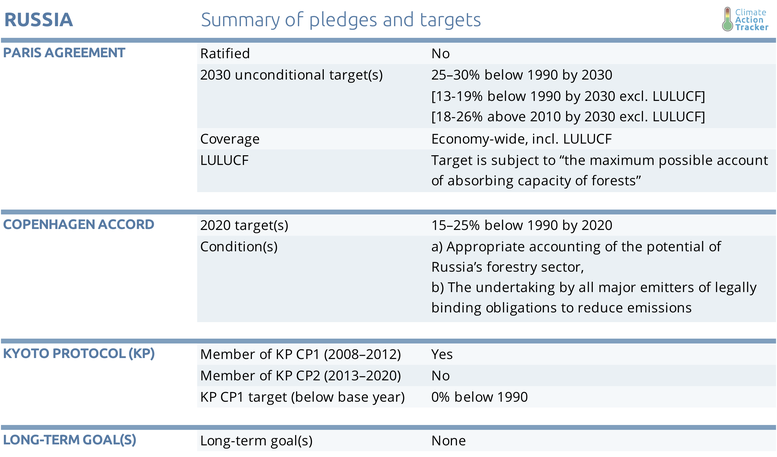Pledges And Targets
Summary table

Paris Agreement targets
On 31 March 2015, the Russian Federation submitted its 2030 Intended Nationally Determined Contribution (INDC), proposing to reduce emissions 25% to 30% below 1990 levels by 2030 (UNFCCC, 2015). The Russian government officially signed the Paris Agreement (PA) on 22 April 2016. The ratification of the agreement and thus the submission of the definitive Nationally Determined Contribution (NDC) are still pending and Russia has presented a national strategy that may delay ratification until at least 2019 (Government of the Russian Federation, 2016).
Our best estimate of the target emissions levels that Russia’s INDC entails is 3.0 GtCO2e to 3.2 GtCO2e in 2030 (13–19% below 1990 levels, excluding LULUCF). These levels were calculated using the most recent projected emissions for the LULUCF sector in 2030 (Ministry of Environment and Natural Resources, 2017), which are higher than in previous projections, moving our estimate of the INDC target excluding LULUCF downwards. Our main assumption for this calculation is that Russia will include the LULUCF sector both in the base year and target year, which would allow for much higher emissions in the target year compared to a situation in which the target excluded LULUCF emissions. This assumption arises from the INDC statement, according to which the 2030 target “is subject to the maximum possible accounting of the absorbing capacity of forests” (UNFCCC, 2015), and is consistent with forecasts provided in the most recent Biennial Report (Ministry of Environment and Natural Resources, 2017).
2020 Pledges
In the Copenhagen Accord from 2009, the Russian Federation pledged to limit emissions by 15–25% below 1990 levels by 2020 (Russian Federation Government, 2010). Due to lack of clarity regarding the inclusion of the LULUCF sector in the 2020 target, in our assessment we show estimates of the resulting 2020 target emissions levels for both, excluding, and including LULUCF in the base year. Under these scenarios, the 2020 target emissions level would be 2.8 to 3.3 GtCO2e, which is 6–24% above 2016 non-LULUCF emissions.
In September 2013, the Russian Federation adopted Decree No. 752 On Reducing Greenhouse Gas Emissions, which set a target of reducing emissions 25% below 1990 levels by 2020. This target was reaffirmed in Decree No. 504-p in April 2014 (Russian Federation, 2014a) and is in line with the lower end of the Copenhagen Pledge’s range, which we have rated as “inadequate”.
Long-term goal
In previous assessments, the CAT had included a long-term target for Russia of cutting GHG emissions by at least 50% below 1990 levels by 2050, based on the announcement made by the former Russian president Medvedev at the L’Aquila G8 Summit in 2009 (Yale Center for Environmental Law, 2011). To date, no official national document has confirmed the Russian Federation’s intention to continue pursuing its long-term target and, with Russia’s membership in the G8 group having been suspended since 2014, there is no reason to expect this target to be included in any national legislation in the foreseeable future. Taking into account the former, in 2017 the CAT decided to remove Russia’s Iong-term target from its country assessment as well as from the calculations of the global aggregate commitments.
Further analysis
Latest publications
Stay informed
Subscribe to our newsletter




